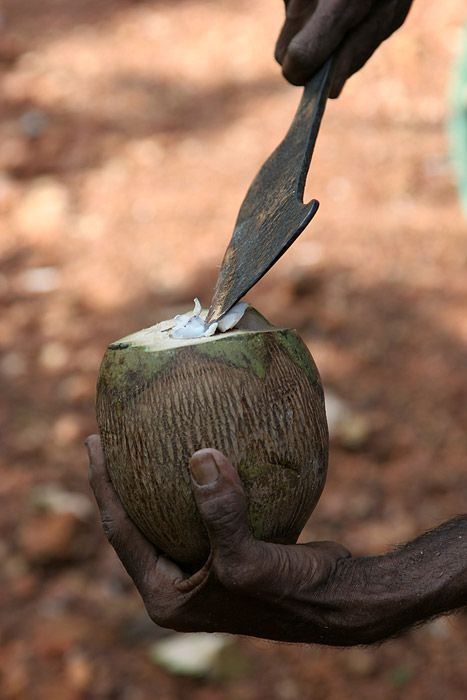|
|
Nutting Coconuts, Goa, Panaji, India
|
Within the shell is a single seed. When the seed germinates, the root (radicle) of its embryo pushes out through one of the eyes of the shell. The outermost layer of the seed, the testa, adheres to the inside of the shell. In a mature coconut, a thick albuminous endosperm adheres to the inside of the testa. This endosperm or meat is the white and fleshy edible part of the coconut. Although coconut meat contains less fat than many oilseeds and seeds such as almonds, it is noted for its high amount of medium-chain saturated fat. About 90% of the fat found in coconut meat is saturated, a proportion exceeding that of foods such as lard, butter, and tallow. There has been some debate as to whether or not the saturated fat in coconuts is healthier than other forms of saturated fat. Like most nut meats, coconut meat contains less sugar and more protein than popular fruits such as bananas, apples and oranges. It is relatively high in minerals such as iron, phosphorus and zinc.
The endosperm are initially in their nuclear phase of development within a hollow interior space as coconut water and air (distinct from coconut milk). As development continues, they mature into their cellular stage and form a rind of tissue known as coconut meat. Immature coconuts are more likely to contain coconut water and less meat. They are often sold with a small portion of the husk cut away to allow access to the coconut water. Young coconuts used for coconut water are called tender coconuts. The water of a tender coconut is liquid endosperm. It is sweet (mild) with an aerated feel when cut fresh. Depending on its size a tender contains 300 to 1,000 ml of coconut water.
The meat in a green young coconut is softer and more gelatinous than that in a mature coconut—so much so that it is sometimes known as coconut jelly. When the coconut has ripened and the outer husk has turned brown, a few months later, it will fall from the palm of its own accord. At that time the endosperm has thickened and hardened, while the coconut water has become somewhat bitter.
When the coconut fruit is still green, the husk is very hard, but green coconuts only fall if they have been attacked by molds or other blights. By the time the coconut naturally falls, the husk has become brown, the coir has become drier and softer, and the coconut is less likely to cause damage when it drops, although there have been instances of coconuts falling from palms and injuring people, and claims of some fatalities. This was the subject of a paper published in 1984 that won the Ig Nobel Prize in 2001. Falling coconut deaths are often used as a comparison to shark attacks; the claim is often made that a person is more likely to be killed by a falling coconut than by a shark, yet such evidence as there is would suggest that the number of deaths due to falling coconuts is small.
|
|









